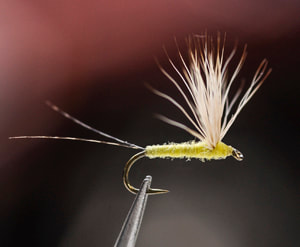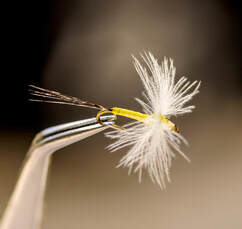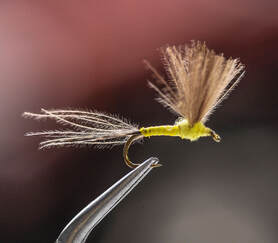Fly of the Month
In the coming months we have a three-part article on the Sulphur Mayfly. Part One will cover the Adult stage, Part Two will cover the Emerger stage and Part Three will cover the Nymph stage. In prior articles, Tom and I have covered the Blue Wing Olive Mayfly which is available to trout on most North Carolina DH waters and Southeastern tailraces, both in the Adult stage and the Nymph Stage. So we decided that we would now cover the Sulphur Mayfly which is present also, and has become the predominate mayfly on the upper portion of the South Holston River tailrace.
On North Carolina DH waters sulphur mayflies are typically medium sized and hatch in sparse numbers. Hold over hatchery raised trout learn quickly that a huge food source on our North Carolina streams are sulphur mayflies from late April to early June. With several distinct species available, there is typically a sparse sulphur hatch on any given sunny day. There are very dense hatches of the E. invaria species of sulphur occurring from early-summer to late-fall on the South Holston River tailrace. Although there may be sulphurs hatching that are as small as size 20 or as large as size 14, there are actually multi-broods of the same species of sulphur rather than several species on the South Holston River tailrace.
Sulphur – Part One – Adults
The primary "Sulfur" hatch on the South Holston River tailrace can trigger many feelings in the angler. There is nostalgia for the days when everything clicked and selective trout were brought to the net. There is frustration from the maddening selectivity that is the source of our excitement. As many as five distinct broods hatch on the South Holston River tailrace during a dense hatch according to Matt Green.
In the past, Sulphurs were somewhat less important to most anglers due to the sparse hatches. Changes from the original rivers habitat to a tailrace of colder, nutrition filled water has created a mega-population of sulphur mayflies in the upper portion of the South Holston River tailrace. This change has made the sulphur receive a lot more attention and a number of sulphur fly patterns have evolved to better match the hatch on the very clear waters of the tailrace.
Ephemerella invaria and Ephemerella dorothea are the two mayfly species known as Sulphurs. The combination of these two prolific species is the most abundant of all mayflies in Eastern and Midwestern trout streams. At one time there was a third, Ephemerella rotunda, but entomologists discovered that invaria and rotunda are a single species with a broad range of variation. This variation and the similarity to the also variable dorothea make telling them apart exceptionally difficult. Thus, science and matching the hatch evolves with each discovery.
The E. invaria hatch begins in early May in Pennsylvania. The Catskills peak in late May and early June, while mid-June is best in the Adirondacks and the northern fringe of the Upper Midwest. Good fishing from this hatch usually lasts about two weeks in a particular location. Here in the south, a sparser hatch begins in late April and generally lasts into early June where water temperatures remain in the 52-60°F range. The time of day varies based on weather but generally occurs mid-afternoon at first and later as the season progresses. Sulphur mayflies may occur almost anywhere along a stream but the best hatches occur near fast runs ad riffles.
The Sulphur Catskill Dry or Sulphur Traditional Dry are all you need to match the hatch on North Carolina DH Waters during a sparse hatch. These fly patterns have an upright and divided hackle tip wing with a variation of body color from pale yellow to bright orange-yellow. The tail may be a sparse clump of hackle fibers or a well-positioned split tail. Some anglers use a Pale Morning Dun (PMD), a Pale Afternoon Dun (PAD), a Pale Evening Dun (PED), a Pale Watery Dun (PWD) or even a Light Cahill to effective match the sparse sulphur hatch. The approximate color match appears to work just fine most of the time. But there are times a brighter yellow of the Yellow May or Yellow Dun fly pattern is required. Also, there are times as orange-yellow body color of the Great Eastern Sulphur, Sulphur Dun or Whirling Dun fly pattern is necessary, especially in very clear water conditions.
A less covered topic about adult mayflies is the final spent stage. In the case of the Sulphur Dun, the spinner fall can be one of the most productive times for the angler. Duns typically molt and return to the water as spinners within one day at dusk. The females drop their eggs in mid-air and are not exposed to trout until they fall spent--if they fall spent at all.
Knopp & Cormier write in Mayflies: An Angler's Study of Trout Water Ephemeroptera that the males seldom fall spent on the water and the females only fall sometimes. Ted Fauceglia's Mayflies says both genders fall spent on the water. This disagreement leaves some confusion about spinner falls which are generally unpredictable, but no one disputes that the brief episodes at dusk can provide excellent fishing.
We provide three recipes for dry fly presentations of the Sulphur Dun and two recipes for the spent adult Sulphur Spinner. The CDC Biot versions of each are slightly more realistic and generally more effective in extremely clear water conditions.
In the coming months we have a three-part article on the Sulphur Mayfly. Part One will cover the Adult stage, Part Two will cover the Emerger stage and Part Three will cover the Nymph stage. In prior articles, Tom and I have covered the Blue Wing Olive Mayfly which is available to trout on most North Carolina DH waters and Southeastern tailraces, both in the Adult stage and the Nymph Stage. So we decided that we would now cover the Sulphur Mayfly which is present also, and has become the predominate mayfly on the upper portion of the South Holston River tailrace.
On North Carolina DH waters sulphur mayflies are typically medium sized and hatch in sparse numbers. Hold over hatchery raised trout learn quickly that a huge food source on our North Carolina streams are sulphur mayflies from late April to early June. With several distinct species available, there is typically a sparse sulphur hatch on any given sunny day. There are very dense hatches of the E. invaria species of sulphur occurring from early-summer to late-fall on the South Holston River tailrace. Although there may be sulphurs hatching that are as small as size 20 or as large as size 14, there are actually multi-broods of the same species of sulphur rather than several species on the South Holston River tailrace.
Sulphur – Part One – Adults
The primary "Sulfur" hatch on the South Holston River tailrace can trigger many feelings in the angler. There is nostalgia for the days when everything clicked and selective trout were brought to the net. There is frustration from the maddening selectivity that is the source of our excitement. As many as five distinct broods hatch on the South Holston River tailrace during a dense hatch according to Matt Green.
In the past, Sulphurs were somewhat less important to most anglers due to the sparse hatches. Changes from the original rivers habitat to a tailrace of colder, nutrition filled water has created a mega-population of sulphur mayflies in the upper portion of the South Holston River tailrace. This change has made the sulphur receive a lot more attention and a number of sulphur fly patterns have evolved to better match the hatch on the very clear waters of the tailrace.
Ephemerella invaria and Ephemerella dorothea are the two mayfly species known as Sulphurs. The combination of these two prolific species is the most abundant of all mayflies in Eastern and Midwestern trout streams. At one time there was a third, Ephemerella rotunda, but entomologists discovered that invaria and rotunda are a single species with a broad range of variation. This variation and the similarity to the also variable dorothea make telling them apart exceptionally difficult. Thus, science and matching the hatch evolves with each discovery.
The E. invaria hatch begins in early May in Pennsylvania. The Catskills peak in late May and early June, while mid-June is best in the Adirondacks and the northern fringe of the Upper Midwest. Good fishing from this hatch usually lasts about two weeks in a particular location. Here in the south, a sparser hatch begins in late April and generally lasts into early June where water temperatures remain in the 52-60°F range. The time of day varies based on weather but generally occurs mid-afternoon at first and later as the season progresses. Sulphur mayflies may occur almost anywhere along a stream but the best hatches occur near fast runs ad riffles.
The Sulphur Catskill Dry or Sulphur Traditional Dry are all you need to match the hatch on North Carolina DH Waters during a sparse hatch. These fly patterns have an upright and divided hackle tip wing with a variation of body color from pale yellow to bright orange-yellow. The tail may be a sparse clump of hackle fibers or a well-positioned split tail. Some anglers use a Pale Morning Dun (PMD), a Pale Afternoon Dun (PAD), a Pale Evening Dun (PED), a Pale Watery Dun (PWD) or even a Light Cahill to effective match the sparse sulphur hatch. The approximate color match appears to work just fine most of the time. But there are times a brighter yellow of the Yellow May or Yellow Dun fly pattern is required. Also, there are times as orange-yellow body color of the Great Eastern Sulphur, Sulphur Dun or Whirling Dun fly pattern is necessary, especially in very clear water conditions.
A less covered topic about adult mayflies is the final spent stage. In the case of the Sulphur Dun, the spinner fall can be one of the most productive times for the angler. Duns typically molt and return to the water as spinners within one day at dusk. The females drop their eggs in mid-air and are not exposed to trout until they fall spent--if they fall spent at all.
Knopp & Cormier write in Mayflies: An Angler's Study of Trout Water Ephemeroptera that the males seldom fall spent on the water and the females only fall sometimes. Ted Fauceglia's Mayflies says both genders fall spent on the water. This disagreement leaves some confusion about spinner falls which are generally unpredictable, but no one disputes that the brief episodes at dusk can provide excellent fishing.
We provide three recipes for dry fly presentations of the Sulphur Dun and two recipes for the spent adult Sulphur Spinner. The CDC Biot versions of each are slightly more realistic and generally more effective in extremely clear water conditions.



